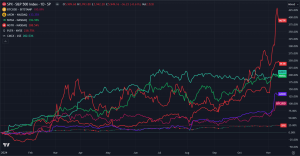If you follow a traditional 60%/40% stock-bond portfolio allocation, you currently should be just 38% invested in equities — 63% of 60%. If your target equity allocation instead is 80%, you should currently be 51% invested in stocks.
These are the implications of a market timing model that keys off changes in the CBOE’s Volatility Index, or VIX
VIX,
for short. The model calls for below-average exposure when the VIX is above average, as it is now: the VIX stands at 31.02, more than double the 14.84 low to which this sunk to last fall.
This model, which I describe in greater detail below, changes its recommended equity exposure just once per month. If the VIX closes February at its current level, then its recommendation for March will be to invest 57% of your target allocation. For a 60%/40% portfolio, that would mean setting your equity exposure to 34%; for an 80%/20% portfolio, it would be 45%.
The model’s direction is surprising for two reasons. The first is that it’s the outcome of academic research, and academics generally have an intense aversion to market timing. But this research, entitled “Volatility-Managed Portfolios,” appeared in the prestigious Journal of Finance in August 2017. Its authors are two finance professors: Alan Moreira of the University of Rochester and Tyler Muir of UCLA. The two published follow-up research in the equally well-regarded Journal of Financial Economics in March 2019.
The second reason this market timing model is so surprising: It in effect says that your emotions may in fact take you in the right direction when managing your investment portfolio. This is directly contrary to the belief of almost every financial planner and adviser that your emotions are to be resisted.
At least when it comes to market volatility, our instincts are onto something. We want to reduce our stock exposure when volatility jumps and increase exposure when volatility declines. That’s exactly what the professors found to be a good strategy.
The professors don’t deny that high VIX levels often coincide with market bottoms, when we presumably would want to have above-average equity allocations. But they point out that the stock market typically will have performed poorly over the weeks and months prior to those bottoms, during which the VIX will be increasing from low levels.
This is precisely what has happened over the past couple of months. Averaging those poor performances with the good returns that follow the high VIX levels at market bottoms, the professors found that the stock market on balance produces subpar returns when VIX levels are high.
This finding, while interesting, does not by itself justify following the professors’ volatility-based market timing model. Another feature of the markets is a crucial prerequisite: periods of high volatility tend to be clustered rather than occur randomly. Both of these features combine to make it a good idea to reduce your equity exposure when volatility begins to heat up. It’s like fastening your seatbelt on an airplane when encountering turbulence.
Following the model
In a series of recent emails, Moreira and Muir outlined a simple way to put their theoretical insights into practice. The approach they suggest is not as methodologically sophisticated as the model they tested in their research, but has the virtue of being easily implemented. The rules are:
- Pick a target or default equity allocation. For example, if you’re following a traditional 60%/40% portfolio allocation, your target or default equity allocation would be 60%.
- Determine a middle-of-the-road VIX level that will correspond with your target allocation. This baseline level is what you will be using to determine your equity exposure. If the VIX is higher than your baseline, your equity exposure will be below your default level — and vice versa.
- To determine your precise equity exposure level for each month, multiply your target allocation by the ratio of your VIX baseline to the closing VIX level of the immediately preceding month.
To illustrate such an approach’s potential, I backtested it to 1990, which is how far back data for the VIX are available. For my default or target allocation, I chose 60%. For the VIX baseline, I chose the median of all VIX readings since 1990, which is 17.59. That means that half the VIX levels since 1990 have been above this level, and half below.
The table below reports the performance of this approach compared to a portfolio that maintains a constant 60% allocation to equities. I credited the 90-day U.S. T-Bill rate to the non-cash portion of my hypothetical portfolios, while debiting margin interest cost when the model called for being more than 100% invested.
| Strategy | Annualized return since 1990 | Standard deviation of monthly returns | Sharpe Ratio |
| Volatility-based market timing model | 7.3% | 2.12 | 1.00 |
| Constant 60% equity | 7.6% | 2.53 | 0.88 |
You will notice that the volatility-based model slightly lagged the portfolio that maintained a constant 60% equity exposure. But, crucially, it did so with noticeably less risk, as measured by volatility — 16% less, in fact. As a result, the volatility-based model did 14% better than the constant-equity-allocation portfolio on a risk-adjusted basis (as measured by the Sharpe Ratio).
You might not be impressed by the strategy’s higher Sharpe Ratio, on the grounds that you “can’t take the Sharpe Ratio to the bank.” But you actually can. Because the volatility-based timing model was 16% less risky, you can increase your target equity allocation beyond your default and still not incur any more risk than you otherwise would have by maintaining a constant equity allocation.
To illustrate, let’s imagine that your target equity allocation, like in my illustration, is 60%. That in effect means you’re already willing to incur the volatility of a portfolio that maintains a constant equity allocation at that level. If so, then you should be willing to follow the volatility-based market timing model with a higher target allocation.
In fact, I calculate that this timing model with a 74% target allocation would be no more volatile than a portfolio that maintains a constant 60% equity allocation. Moreover, this 74% target allocation portfolio would have produced an 8.3% annualized return since 1990 — well-ahead of the constant allocation portfolio.
In other words, you can take a higher Sharpe Ratio “to the bank.” And the amounts involved are substantial, as my illustration suggests. For their 2019 study that appeared in the Journal of Financial Economics, the professors tested a volatility-based timing model over a much longer period than I focused on in my backtest — 1925 to 2016 — and found that an “investor who ignores variation in volatility gives up the equivalent of 2.4% of wealth per year.”
Is there a catch? The biggest one may be that you won’t in the moment follow the model’s recommendations. All too often, Moreira points out, investors who sell when volatility rises don’t buy in when volatility recedes, thereby missing out on much of the market’s gain. If you’re disciplined enough not to do that, then you may want to consider varying your equity exposure as volatility waxes and wanes.
Mark Hulbert is a regular contributor to MarketWatch. His Hulbert Ratings tracks investment newsletters that pay a flat fee to be audited. He can be reached at mark@hulbertratings.com
More: S&P 500’s correction comes with first ‘bullish divergence’ chart signal
This post was originally published on Market Watch






